A/C Troubleshooting Tips
Don’t Ignore Air Conditioning Problems.When you have a big air conditioning problem – like an air conditioner that quits during the hottest day of summer – it goes without saying that you’ll call for service. Smaller air conditioning problems are easier to ignore, but ignoring them is the last thing you should do. By calling for service as soon as you notice the symptoms of an ailing cooling system you can prevent the expense and inconvenience of a big repair job. You may also avoid the higher utility bills that typically accompany a poorly functioning air conditioning system. You should have your air conditioner checked when you notice any of the following symptoms:
- Decreased air flow from the registers;
- Strange noises coming from the air conditioner;
- Moldy odors coming from the ductwork when the air conditioner is running;
- The air conditioner cycles on and off more frequently than it used to;
- The breaker for the air conditioner in the electrical panel keeps tripping (or the fuse keeps blowing);
- Ice appears on your air conditioner or piping, either inside or outside the house;
- Your outdoor fan in the air conditioner won’t come on.
Heating Troubleshooting Tips
Below is a list of common problems and things to check before calling a professional for a non-functioning heating system.Thermostat Check
- Is the system selector switch in the “heat” position?
- Is the temperature set at least 3 degrees above current room temperature?
- If your thermostat is electronic, are the batteries charged? Is the display showing?
- Forced Air Furnaces Only: If your thermostat has a switch to control the furnace fan, switch the fan “ON”. (This switch will usually be located at the bottom of the thermostat, closer to the left side and will be marked “ON” and “AUTO”.) Listen to hear the furnace fan coming on. If you cannot hear the fan, go to one of the supply registers and see if you can feel any air coming up. If the fan is not running, there may be no power to the furnace.
Electrical Check – FURNACE
- Your heating system may be equipped with an emergency shut-off switch for the furnace. If so, locate it and make sure it is turned on. In most homes the emergency shut-off switch looks just like a regular light switch and will be located on the side or close to the furnace. (Sometimes there is a second switch at the top of the basement stairs) It is quite common for this switch to be turned off accidentally. If the switch is ON, but the fan still doesn’t operate, proceed to the ELECTRICAL PANEL CHECK.
- Some heating systems also have emergency cut-out switches that are activated when a door or service panel is removed. Often the furnace door is not replaced properly after a filter cleaning and the cut-out switch will prevent the furnace from coming on. Check to make sure all access doors are properly secured and fitted.
To make sure that the main power is on to both the furnace and air conditioner, locate the breaker or fuses in your home’s main electrical panel for the furnace and air conditioning unit. Make sure the breakers are not tripped or the fuses are not blown.
- If your home has breakers, check to see if any are tripped. If a breaker has been tripped it will be in a position that is between ON and OFF. Reset the breaker (turn all the way OFF, then
back ON). - If your home has fuses, check to see if the fuse for the furnace is blown. If so, replace it with the SAME SIZE fuse. Do not increase the size of the fuse.
- WARNING: If a breaker keeps tripping or a fuse keeps blowing, you should contact a qualified service technician to inspect your system to determine why you are having problems.
If you have determined that there is power to the furnace and you are still not getting any heat, look for any troubleshooting guides that came with the furnace for additional help. If all else fails, please give us a call.



No comments:
Post a Comment